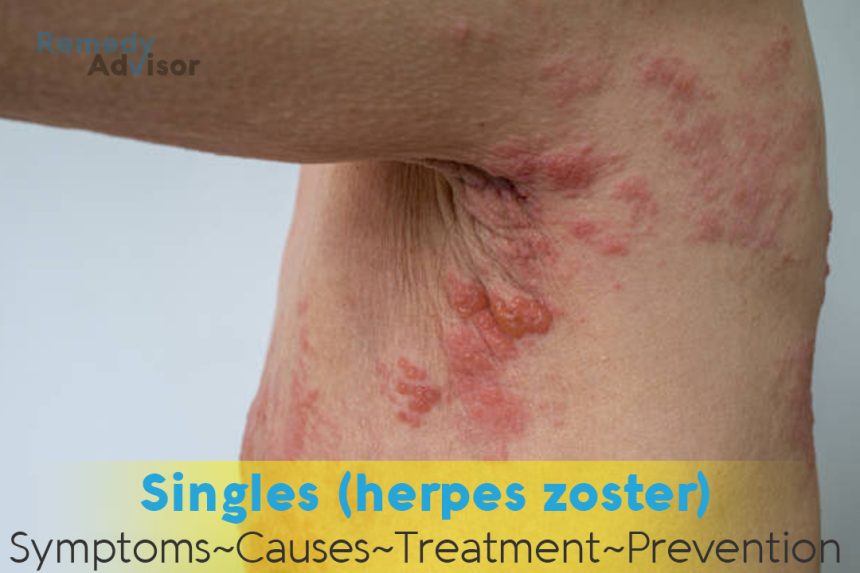What is it
Herpes zoster, more commonly known as shingles, is a painful viral infection caused by varicella zoster, the same virus that causes chicken pox. After a childhood attack of chicken pox, the virus lies dormant in the nerve cells that extend from the spinal cord or the brain. In adulthood, the virus can be reactivated, resulting in a second eruption of chicken pox. (Therefore, you cannot develop shingles unless you have had an earlier case of chicken pox.)
The blistery rash characteristic of shingles follows a line on one side of the body or face in an area supplied by a particular spinal nerve. This band-like pattern gives the ailment its name: shingles comes from cingulum, the Latin word for belt or girdle (though the name is actually a misnomer, since the rash never crosses the midline of the body). Zoster, the medical term for the disease, comes from the Greek word for girdle.
Shingles strikes about one in five adults who have had chicken pox as children. While young people do develop shingles, the ailment most often occurs after age 50, with the incidence increasing with age. The chance of developing shingles is greatest for people whose immune system is weakened for example, people infected with the HIV virus or cancer patients undergoing drug or radiation treatment.
You cannot “catch” shingles from someone who has it. The virus can be transmitted to others, but only to someone who has never had chicken pox and only if that person is exposed to the rash in which case the person may develop chicken pox, not shingles. If you have shingles, you should avoid contact with small children, pregnant women, and any adults who have never had chicken pox. (In the United States, 95 percent of adults have had the disease; those who have not should be immunized, since many adults with chicken pox have higher fevers and more complications than children.)
The prognosis for shingles is generally good, unless the virus spreads to the brain or eyes. For most normally healthy individuals, the lesions heal and pain diminishes within three to five weeks.
However, some shingles sufferers including as many as 50 percent of the sufferers over age 50, according to some estimates will have debilitating pain that persists for more than one month (sometimes for many months) after lesions have healed. This pain, called post-herpetic neuralgia, or PHN, is not from shingles but from nerve cell damage caused by the viral infection.
Symptoms
- Burning pain, tingling, and extreme sensitivity in one area of skin; the pain may last for one to three days before the skin reddens at the pain site.
- Mild chills and fever, malaise, headache.
- A rash of small fluid-filled bubble like blisters that breaks out on reddened skin. The rash forms along a band, most commonly on the torso and buttocks, but also on the arms, legs, and face. In nearly all cases the rash occurs only on one side of the body.
- Within about 1 days, the blisters form scabs.
What causes it
No one is certain what triggers an attack of shingles. Researchers believe that the virus is reactivated when the immune system becomes too weak to keep the virus in a dormant state. This is probably why older people are more likely to get the infection. Stress and illness may also weaken the immune system, as does the use of immunosuppressant drugs. The immune system factor may also explain why people with AIDS. Hodgkin’s disease, and other cancers whose immune systems are suppressed due to illness or treatment for illness are at increased risk of developing shingles.
What if you do nothing
In most cases shingles is self-Limiting. The body’s immune system is ordinarily able to fight off the infection though the pain can be severe, and many people need medication for pain relief Medical intervention is critical, however, for people with damaged or suppressed immune systems. Not only are they vulnerable to shingles, but if they develop symptoms, there is a danger that the disease will spread and reach vital organs like the lungs, with results that are fatal.
Home remedies
Shingles can’t be cured, so remedies are aimed at relieving pain, which can range from mild to severe.
Relieve the pain
For minor discomfort, take over-the-counter NSAIDs (aspirin, ibuprofen, or naproxen) or acetaminophen.
Cool it
Apply cool wet compresses or ice packs to reduce pain. Calamine lotion may also feel soothing if applied after removing the compresses.
Relieve the itch
Soak in a bath to which you’ve added colloidal oatmeal.
Don’t scratch
Although it is hard to resist scratching, you increase the risk that the blisters will become infected from the dirt on your fingernails.
Rest
If you are overly fatigued or develop a fever, rest in bed.
Try deep heat
Capsaicin cream, an extract made of hot peppers, has been used in pain clinics to reduce the pain of PHN victims by interrupting the transmission of pain impulses to the brain. This over-the-counter remedy is sold for treating muscular aches and pains, but consult your physician before using it. Be sure not to apply it until the lesions caused by your shingles have completely healed.
Clean regularly
Use soap and water to keep the rash area clean. This will prevent any bacterial infections from developing.
Prevention
There is no way to prevent shingles. However, to be on the safe side, if you’ve never had chicken pox, it’s best to avoid contact with the active rash of anyone with shingles or chicken pox.







